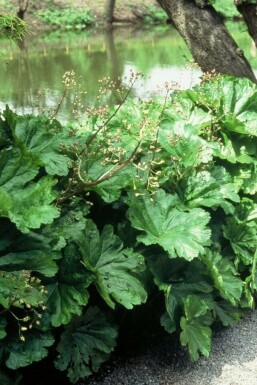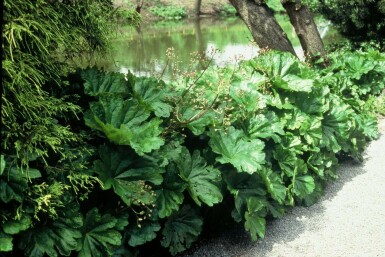

100cm




Updated on 10 September 2025
We regret to inform you that we are currently unable to ship orders to the United Kingdom. We anticipate being able to resume shipments at the beginning of 2026.
Darmera adds striking structure to any garden, perfect for damp areas like pond edges or shaded spaces. It blooms pink in spring before its large umbrella-shaped leaves emerge. This plant is insect-friendly, offering visual interest and supporting biodiversity in a garden.


100cm




Darmera is a striking plant, known for its unique umbrella-like large leaves and charming pink flowers that bloom on thick leafless stems in early spring. As summer approaches, these giant leaves provide a bold presence in any garden. Perfect for moisture-loving areas, Darmera thrives in bank and marsh gardens, offering dramatic leaf contrast in shaded locations. This structural plant is a must-have for those looking to enhance their damp garden spots. Curious about how Darmera can transform your space? Consider adding this marsh plant with its impressive pink bloom to your collection. Whether for a shade bank or as part of your pond's marginal perennials, Darmera is available for purchase in the UK.
Darmera, also known as umbrella plant, is a moisture-loving perennial that thrives in wet and shaded gardens. Recognised by its large, round leaves and pink umbels, Darmera is also called Indian rhubarb and bog rhubarb. It belongs to the Saxifragaceae family and originates from the west coast of the USA, particularly Oregon and California. In a garden setting, Darmera is perfect for waterside planting, pond edges, and forest edges. It plays an important ecological role by providing shade for small aquatic animals and attracting bees with its flowers. Named after botanist Karl Darmer, the plant symbolises transition and softness, as it dramatically blooms from bare ground. As a perennial, Darmera grows well on wet banks and is deciduous, meaning it loses its leaves in winter. Its rhizome spread ensures it can fill a garden space effectively, making it an excellent choice for group planting or as a specimen. Those looking for pond marginal perennials in the UK often choose Darmera for its unique appearance and adaptability. Consider incorporating Darmera into a shaded garden or as a natural garden element to enhance the landscape.
The Darmera is a distinctive garden plant with large leaves and striking spring bloom. This perennial plant thrives in moist conditions, making it ideal for planting by ponds or shaded gardens. Known for its marsh-like growth, it uses runners to spread, forming a lush ground cover. The development of Darmera begins in early spring, when its pink flowers emerge on thick, leafless stems. These blooms appear before the large, umbrella-like leaves, creating a unique display. As the season progresses, giant leaves take over, providing excellent ground shade. Darmera blooms between April and May. Its flowering depends on several factors including temperature and soil moisture. Cool, wet springs promote vibrant blooms, while drier conditions might delay flowering. The plant's age and proper ground preparation also play significant roles in bloom quality. The flowers are primarily pink, ranging from light to soft shades. These hues are influenced by the soil type, light exposure, and specific cultivar. Proper care and adequate shade enhance the colour vibrancy. While Darmera is not notably scented, its bold foliage adds visual interest to any garden setting. Leaves and stems may contribute subtle scents during rain, enhancing biodiversity without overpowering other plants. A mature Darmera varies in height, typically reaching 30 cm to 1 m. This depends on the planting location, climate, and soil quality. Proper care ensures optimal growth, making it a standout feature in marsh plant large leaf designs.
Darmera is a striking plant with very large, round, kidney-shaped leaves that add an architectural effect to gardens. The leaves start off as a fresh green and transform to a vibrant orange-red in autumn, providing seasonal interest. The ribbed texture of the leaves not only enhances their visual appeal but also plays a role in protecting against evaporation. This makes Darmera a great choice for planting at pond edges in the UK. It is important to note that Darmera is hardy, tolerating temperatures between -34°C to -23°C, making it suitable for USDA zones 4 to 6. The rhizome of Darmera can thrive in wet soils, which aids its survival during frosty periods. However, it is also important to consider wind exposure and soil conditions to ensure the plant’s health during winter. Darmera is not evergreen; it loses its leaves annually like most perennials, influenced by climate and planting location. It is drought-tolerant to some extent due to large leaves and a deep root system, though it prefers moisture-rich conditions. Darmera is generally non-toxic, posing no threat to humans or animals, making it a safe option for gardens with children and pets. Ecologically, Darmera provides significant value. Its umbrella-shaped leaves offer shelter for small creatures, while the pink flowers that appear in April to May before the leaves emerge attract pollinators like bees. Choosing to plant Darmera can increase biodiversity by mimicking natural wetland habitats and supporting a balanced ecosystem.
Darmera is a fantastic choice for adding interest around pondsides and in bog gardens. Known for its love of moisture, it thrives in wet conditions and provides a striking visual impact in these settings.
Darmera is a striking addition to any garden, especially in areas with moist soil and shade. Combining it with other moisture-loving plants enhances its beauty. One excellent pairing is with Rodgersia. The bold, textured leaves of Rodgersia provide a stunning backdrop for Darmera's large foliage. Another great companion is Ligularia, which adds bright yellow blooms that contrast with the pink blooms of Darmera. Astilbe is also a fantastic choice; its feathery flowers complement the bold leaves of Darmera. For more leaf contrast, Hosta can be planted alongside, offering a range of green shades. Filipendula is another option, with its large leaves and delicate flowers. These combinations not only enhance Darmera's visual appeal but also create a lush and varied garden. Darmera has impressive foliage and thrives among large-leaved foliage plants. To make the most of the shade bank, consider these plant pairings for a dynamic and thriving garden environment.
Darmera thrives in partial shade, making it ideal for gardens with limited sunlight. It prefers moist, shady spots, which help the plant maintain its vibrant green leaves and pink umbels. The large leaves of the bog rhubarb reduce evaporation and provide additional shade to the soil below. Wind can affect Darmera, so it's best to plant it in sheltered areas or use windbreaks to protect it. The best soil for Darmera is moist, marshy, and nutrient-rich. While the rhizome can tolerate wet soils, a well-draining substrate is essential to prevent waterlogging. Regular feeding and soil enrichment with compost will further support vigorous growth. For optimal moisture retention, consider mulching the base. Darmera, a moisture-loving perennial, enjoys an acidic to neutral pH level. Ensure the soil pH is within this range to support root health and nutrient uptake. Monitoring soil moisture and adjusting watering based on weather conditions is crucial. Remember, the right balance of light, wind protection, soil, and water is key to successful Darmera cultivation.
Darmera, also known as the umbrella plant, can be planted in spring or autumn. The soil should be moist and fertile to encourage growth. It is best to avoid planting during frost periods. Plants in pots can be planted all year round, except during frost, while plants with roots or clumps do best in spring and autumn.
The planting distance for Darmera depends on factors like the size of the plant at planting and its growth speed. Typically, the information about the number of plants per meter is available on the plant's product page. A spacious planting distance allows the large leaves to spread well.
Prepare the ground well by using fertile and moist soil, ideally enriched with compost. Heijnen planting soil is recommended to ensure a good start. Plant Darmera at the same depth as they arrived in their pot, in a shady or partially shaded location.
Water Darmera regularly after planting to keep the soil moist, especially in dry spells. This moisture-loving perennial does not require much fertilising if the soil is rich in nutrients. The large leaves of Darmera help to reduce evaporation, making it ideal for a bog or marshy area.
The Darmera, also known as the umbrella plant, is a moisture-loving perennial that thrives in shady, wet areas. It produces beautiful flowers from April to May before its large leaves appear. This plant is perfect for waterside planting and can be an excellent choice for pond edges and shaded gardens.
Darmera is a unique plant with large, eye-catching umbrella-shaped leaves that provide a striking visual presence in the garden. In spring, it blooms with pink flowers before the foliage appears, adding early colour to damp areas. The leaves turn a beautiful orange-red in autumn, enhancing its seasonal appeal. As a marsh plant with large leaves, Darmera is excellent for adding texture and structure. It is also an insect-friendly choice, attracting bees and butterflies. The plant's foliage offers shelter to small wildlife and acts as a natural privacy screen. Darmera prefers moist areas and thrives as a garden plant for wet soil. This moisture-loving perennial fits well in shady gardens and along water edges, blending with other bog perennials like Indian rhubarb. Darmera peltata adds a bold contrast to softer plants, making it ideal for a shade bank garden.
Darmera, often known as the umbrella plant, is a stunning perennial that thrives in damp garden areas. Known for its architectural foliage and striking pink umbels, Darmera is a favourite among gardeners looking to add lush greenery near ponds and water features. These plants have a unique charm and are well-suited for environments that mimic their natural habitat by the water's edge.
Darmera is a versatile plant with many attractive features. Known for its beautiful blooms, it can enhance any garden with its unique presence.
Advantages:
Disadvantages:
Proper soil preparation, the right location, and timely care and fertilisation can reduce the risk of diseases and pests. Always ensure good care for optimal growth and bloom.
Darmera is an excellent choice for those looking to enhance their garden with a moisture-loving plant. Perfect for pond edges and marshy areas, Darmera thrives in water-rich environments. Its striking blooms appear in April and May, before the leaves, adding an early touch of colour. As a structural plant, it offers a bold presence with its large leaves, providing contrast in shady spots. The umbrella plant is not only visually appealing but also friendly to insects, making it a valuable addition for biodiversity. With its shade tolerance and rhizome spread, Darmera is a reliable choice for creating a lush, green setting. Its water requirements make it ideal as one of the pond marginal perennials in the UK. Buy Darmera crowns today to transform your garden into a vibrant, living space. Buy Darmera (Indian Rhubarb) from Heijnen – a marsh-loving eye-catcher with striking leaf rosettes and spring bloom.
We would like to provide some tips on how to plant and care for a Darmera. By following these tips, you can be sure to enjoy your Darmera for a long time.
Darmera thrives in moist, marshy locations with nutrient-rich soil. It grows best in partial shade, making it ideal for waterside planting or forest edges. Ensuring the soil is acidic to neutral and well-drained is important for healthy growth. Large leaves help protect it from evaporation, and the rhizome can tolerate wet soils, which is beneficial. Planting Darmera in spring or autumn, when the soil is adequately moist, encourages strong growth. A perfect standplaats ensures vibrant leaves and robust health. The umbrella plant benefits from its preferred environment, resulting in better growth and richer foliage. It is suited for use in pond edges, shaded gardens, or as a structural plant in natural gardens. Proper placement is crucial for its growth and blooming, enhancing its resilience and beauty in any garden setting.
Preparing the soil properly is a crucial step before planting Darmera. Working the ground enhances water permeability and mixes in nutrients and organic materials like compost. This is important for healthy plant growth and should be done before planting. Pot-grown Darmera can be planted year-round, avoiding frost periods. For others with a jute sack, plant in spring or autumn without removing the jute. After planting, water Darmera regularly until rooted in the soil. The size of the Darmera at planting determines the number of plants per square metre. Ensure the soil is fertile, moist, and well-prepared, especially since Darmera thrives in shady, marshy environments. Regular watering and the right soil conditions will help the umbrella plant establish quickly and ensure beautiful pink blooms and large leaves. Remember, proper soil preparation and care are key to successful growth.
Fertilising Darmera, also known as the umbrella plant, is essential for its growth and vibrant appearance. Timely fertilisation enhances its flowering and maintains the health and vitality of this moisture-loving perennial. Using organic fertilisers like those from Heijnen ensures a steady release of nutrients, promoting strong growth and rich blooms without harming the environment. It's recommended to fertilise twice a year: once in early spring and possibly again in summer, especially if the plant reflowers. The amount of fertiliser depends on the plant's size, but generally, a balanced application is advised. Ensure that the fertiliser is absorbed by watering the garden during dry spells, as nutrients are activated with moisture. Darmera thrives in environments like pond edges and shaded gardens, where its pink blooms and vibrant foliage can truly shine.
Darmera thrives in humus-rich, moist soil and is best pruned in early spring after it finishes flowering. Cutting back brown leaves in autumn keeps the plant tidy. This pruning encourages new growth and healthier leaves. Dividing the plant every 4-5 years also helps maintain its vigour. Using sharp secateurs is important to ensure clean cuts and prevent damage. Regular pruning benefits the umbrella plant, promoting better air circulation and reducing overcrowding. Always ensure tools are clean to maintain plant health. For optimal results, focus on maintaining its natural shape and only remove necessary foliage. This approach will ensure a stunning display in the garden, enhancing its beauty throughout the growing season.
Darmera requires a good amount of water and thrives in moist, humus-rich soil. Each species within the genus shares this need. Newly planted Darmera needs regular watering to establish roots. Once rooted, water is needed only during extended dry periods. Giving ample water less frequently is more beneficial than small daily amounts. Watering during cooler times of the day reduces evaporation. Checking the soil is essential to determine if watering is necessary. Excess water must drain away, whether in the ground or pots. Drip hoses are only effective once Darmera is fully rooted; initial planting also requires hand watering. Darmera is poorly drought-tolerant and quickly wilts without moisture. Umbrella plant care includes ensuring consistent soil moisture for optimal growth and health.
Darmera is a fascinating plant known for its large, umbrella-shaped leaves and striking pink flowers. Early in spring, it blooms even before the leaves emerge, creating a dramatic effect. This plant thrives in damp gardens and near water edges. It's not toxic to humans or animals, making it a safe addition to any garden. Additionally, it provides structure and is insect-friendly, making it a valuable choice for enhancing ecological diversity. The Darmera, or umbrella plant, is also symbolic of transition and softness, named after botanist Karl Darmer.
Dividing Darmera is crucial for plant health. This process rejuvenates the plant and removes old parts. Regular division every three to four years keeps it thriving. Benefits include increased vigour and more umbrella plant growth in the garden. Start by carefully digging up the plant, removing any old sections, and replanting the young rhizomes. It is best done in autumn for optimal results. Use a sharp spade or knife for clean cuts. Dividing Darmera ensures the plant lives longer and stays healthy, providing a fresh look to the garden. Besides, it helps manage plant size and encourages more blooms. Always ensure the tools used are clean to prevent any infections. Proper care leads to a flourishing garden.
The umbrella plant offers a striking spring display with its pink flowers on thick, leafless stems. Its large, umbrella-shaped leaves provide structural interest and are perfect for water edges. As an insect-friendly shade plant, it enhances the garden's biodiversity. Ideal for moist, shady areas, it contrasts beautifully with other foliage. Buy Darmera (umbrella plant) from Heijnen, the perfect choice for a vibrant garden addition.
